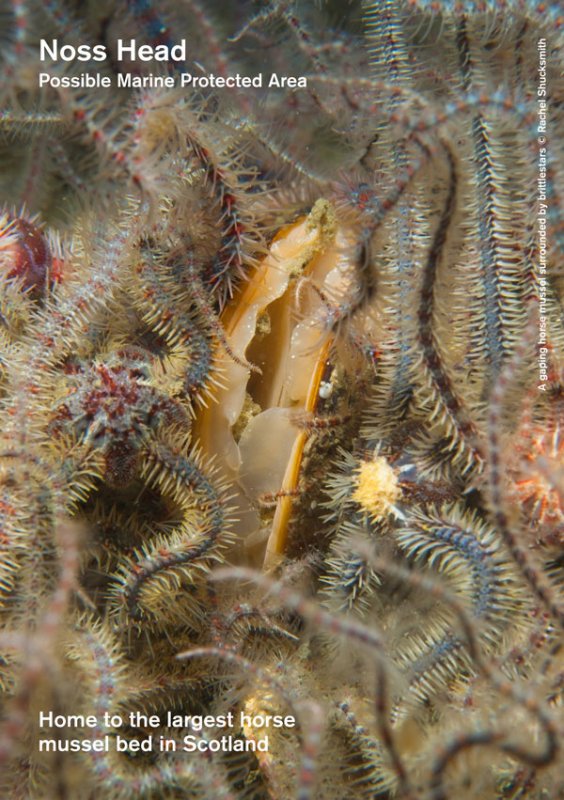The Noss Head Marine Protected Area (MPA) located off the coast at Wick in the north of Scotland supports the largest known horse mussel bed in Scottish waters. The bed lies in depths of between 35 and 45 m. Horse mussels resemble the perhaps more familiar blue mussels of the seashore, but are much larger at 10-20 cm long. The shell is very thick and dark blue to black in colour, with a glossy brown covering. In Gaelic, horse mussels are called ‘clabaidh-dubha’ (‘clabby doos’), meaning big black mouths! [1]
This site was designated in 2014 to conserve the horse mussel beds found within the site. This site now has fisheries management measures in place.
We supported the proposed approach to prohibit the operation of bottom towed gear throughout this site. Horse mussels produce adhesive threads that weave together with those of their neighbours to form a nest-like structure, which becomes an important sea bed habitat for many other types of marine invertebrates and plants. These biologically engineered habitats are also important nursery areas for juvenile fish and commercially important species of shellfish, such as scallops.
Bottom-towed fishing gear is abrasive to the sea bed and can cause lasting damage to habitats such as horse mussel beds. This was made well known when once extensive horse mussel beds in Strangford Lough, Northern Ireland, were heavily damaged primarily as a result of commercial fishing activity and, as a result, the local marine biodiversity supported by this habitat decreased. These horse mussels are now struggling to recover in the face of other pressures, such as climate change and exposure to extreme conditions. We want to make sure that this doesn’t happen to our horse mussel beds in Scotland and the prohibition of the use of bottom-towed fishing gear on or around this habitat will mean that it is kept in good condition and will continue to support a large amount of biodiversity.
Read our response to the 2015 consultation on management measures for this site here:
We fully support the proposed management approach to prohibit the use of mobile demersal
fishing gear throughout the site.We agree with the management advice to remove/avoid pressure for the horse mussel bed, as any
activity which has abrasive impacts or which causes an increase in suspended sediment on or near
the horse mussels may risk the health of the bed and the biodiversity it supports. Horse mussels are
important seabed engineers and provide important nursery habitat for juvenile fish and shellfish.
Scientific research provides ample evidence to support the prohibition of the use of mobile demersal
gear on horse mussel beds and we can learn from the example of Strangford Loch in Northern
Ireland, where the horse mussel beds are struggling to recover from damage caused by intensive
fishing activity.The use of static gear on and around the horse mussel bed should be monitored closely to ensure
that this practice is conducted sustainably and without causing damage to the horse mussel bed.
Should any evidence arise to indicate that damage was being caused, static gear should be
prohibited from this MPA.We are concerned about the dredge disposal site located to the south west side of the MPA and
seek assurance that the boundary of the MPA has been demarcated with a sufficient buffer between
the disposal site and the horse mussel bed, or that the disposal site could be moved further away.
Additionally we are concerned about the impacts of the submarine power cable, which runs through
the MPA and was consented prior to its designation. We seek clarification as to how any potential
impacts from the cable or maintenance activities will be mitigated to protect the horse mussel bed.
Our response to 2013 MPA network consultation
Socioeconomic Assessment:
Save Scottish Seas campaign members have assessed the Scottish Government’s MPA proposal for this site as part of its consultation response.
LINK supports the designation of the Noss Head possible Nature Conservation MPA to protect horse mussel beds. We support the position of the boundary. We note that the extent is currently predictive and therefore, given the importance of this site as the largest known UK horse mussel bed, support the boundary providing a buffer around the predicted distribution.
The conservation objective of ‘conserve’ is supported.Management Options:
Spoil dredge disposal and use of towed/active gears is incompatible with the health of the horse mussel beds and should be excluded from the possible MPA. Recent findings of the damaging impact of towed/active gear on horsemussel beds in the Isle of Man provide further compelling evidence of the need to exclude such gear. Static gear activity should be limited, subject to further study, for both shellfish stock management and biodiversity (horse mussel bed) protection purposes.The potential value of the Noss Head possible MPA to divers and anglers has been estimated at £4.7million to £9.9million based on willingness-to-pay measures (Kenter et al., 2013) . Kenter et al. also found important emotional and well-being benefits associated with the Noss Head possible MPA, with divers and anglers responding to questionnaire scoring >4 (out of a maximum score of 5) for engagement, therapeutic and transformative wellbeing indicator values.LINK supports the designation of the Noss Head possible Nature Conservation MPA to protect horse mussel beds. . We also note the importance of horsemussel beds for wider ecosystem function, providing a range of important services such as drawing down and consolidating sediment to the seabed, sequestering carbon and providing a cryptic, biogenic habitat to support wider biodiversity, including juvenile commercial fish and shellfish species. Protection and management of this site provides an excellent opportunity to further study the important ecosystem function of horsemussel beds.
Check out the official documents relating to the Noss Head MPA on the Scottish Natural Heritage website.
[1] Noss Head MPA Site Summary Document, SNH

